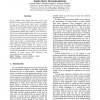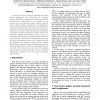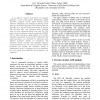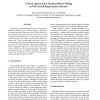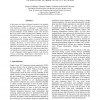CNSR
2007
IEEE
14 years 5 months ago
2007
IEEE
Wireless sensor networks have mainly been designed for information-collecting purposes, such as habitat monitoring, product process tracing, battlefield surveillance, etc. In orde...
CNSR
2007
IEEE
14 years 7 months ago
2007
IEEE
Search engines have turned into one of the most important services of the Web that are frequently visited by any user. They assist their users in finding appropriate information. ...
CNSR
2007
IEEE
14 years 7 months ago
2007
IEEE
This paper presents a data routing protocol for a non-mobile, locationaware wireless sensor network that is primarily designed for continuous monitoring application (e.g. environm...
CNSR
2007
IEEE
14 years 9 months ago
2007
IEEE
— This paper investigates implementation and design issues for a heterogeneous network for structural monitoring. The proposed application uses wireless sensors and the controlle...
CNSR
2007
IEEE
14 years 9 months ago
2007
IEEE
The theory of natural movement is fundamental to space syntax: a set of theories and methods developed in the late 1970s that seeks, at a general level, to reveal the mutual effec...
CNSR
2007
IEEE
14 years 9 months ago
2007
IEEE
Providing web service replicas improves the overall system performance and redundancy for hardware failures. In Business-to-Business, this may be particularly interesting for orga...
CNSR
2007
IEEE
14 years 9 months ago
2007
IEEE
In an effort to improve performance of congested gateways, a new Active Queue Management (AQM) algorithm, Adaptive Virtual Queue Random Early Detection (AVQRED), was developed by ...
CNSR
2007
IEEE
14 years 9 months ago
2007
IEEE
In this paper, conceptual frequency rate, a new frequency definition suitable for query stream mining, is introduced. An online single-pass algorithm called OFSD (Online Frequent...
CNSR
2007
IEEE
14 years 9 months ago
2007
IEEE
Critical infrastructure systems are complex networks of adaptive socio-technical systems that provide the most fundamental requirements of the society. Their importance in the smo...
CNSR
2007
IEEE
14 years 9 months ago
2007
IEEE
In this paper, the issue of channel estimation with multiple In-Cell co-channel Users (ICUs) in the presence of Out of Cell Interferers (OCIs) is addressed. A Single Carrier Frequ...

